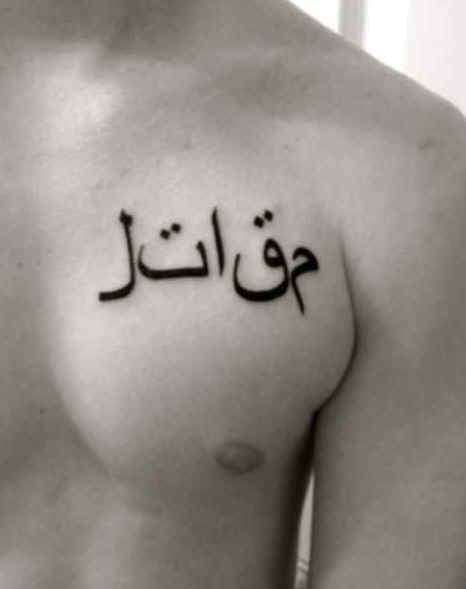Henna
Skin decoration in the Arab world is practised mostly by women and takes the form of designs on hands and feet using henna, which fades away over a period of days or weeks. Increasingly, street artists in resorts such as Marrakesh and Sharm el-Sheikh also provide henna decoration of varying quality for visiting tourists of both sexes.
Henna comes from the leaves of a shrub or small tree calledLawsonia inermisand is usually sold in Arab markets in powdered form. For use, the powder is mixed into a paste, applied to the skin and left to try. When the dried paste is removed a brown stain is left behind on the skin.
Designs can be applied freehand (for example, with a small syringe) or using stencils bought from the markets.
Natural henna should not be confused with a substance known as "black henna" which can causeserious ill-effects.

Hands decorated with henna
Tattoos
Although tattoos can be seen in many Arab countries, tattooing is not a particularly Arab tradition and strict Muslims disapprove of it (click herefor an explanation).
Tattooing is nevertheless common among the Berbers of north Africa, where small designs with symbolic meaning are used (mainly by women). Egyptian Christians often have a cross tattooed on their hand or wrist. These designs tend to be very simple and crudely done. There is no Arab tradition of elaborate tattooing as seen, for example, among Maoris and Pacific islanders.
Nevertheless, tattoos in Arabic and other non-Roman scripts have become popular among westerners and if you decide to get an Arabic tattoo it's advisable to check beforehand that the script is used correctly and that the Arabic says what you meant it to say. The best way of doing that is to check it with native Arabic speakers – and preferably more than one.
There areplenty of examplesto be found on the internet of Arabic tattoosgone wrong– a lot of them designed by people who have simply copied individual Arabic letters with no idea of how to combine them into words. Letter shapes can vary depending on their position in a word (see al-bab's section on theArabic alphabet).

The picture above shows a very common mistake – often caused by computers which have not been set up properly for handling Arabic text. The tattoo is meant to say "muqatil"(fighter) but the letters have not been joined together to form a word and the result.
Name tattoos in Arabic
"Name" tattoos are fairly straightforward but there are still a few pitfalls. Most non-Arabic names can be easily adapted to the Arabic script, but there may be more than one possible spelling. TheTattoo Translatewebsite provides automated transliteration of non-Arabic names but these are not necessarily the transliterations that Arabs would normally use.
It's also worth checking whether the Arabic version of a name has some unintended meaning. For example, transliterating "Polly" produces an Arabic word meaning "urinary".
Phrases in tattoos
Tattoos based on phrases – lines from songs or poems, proverbs, favourite sayings or idiomatic expressions – which have been translated into Arabic have even more potential to go wrong. Literal translations of the sort that Google Translate produces are quite likely to be Arabic gobbledegook.
Calligraphic tattoos
For many people, tattoos using Arabic calligraphy have more visual appeal than standard Arabic text lettering. There are various calligraphic styles and examples of these can be found on al-bab'scalligraphy page.
It is generally not a good idea to make tattoos out of any existing works of Arabic calligraphy that happen to take your fancy. Not only is this unfair to the artists, but the designs usually contain religious quotations and their use as tattoos, especially by non-Muslims, could be considered offensive.
For religious reasons some calligraphers (e.g.Mamoun Sakkal) refuse to design tattoos, but there are others who will happily provide custom-made designs for tattoo purposes. One of them isJosh Berer, and more can be found on the internet.
Again, if you decide to enlist a calligrapher, it's worth checking out opinions about the quality of their work.
Articles
Arab Ink Project: Exploring the Middle East through tattoos
By Chris Scott. CNN, 6 March 2017


